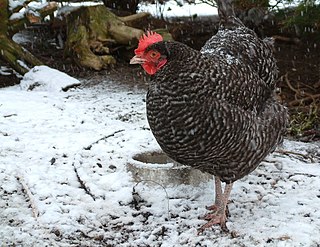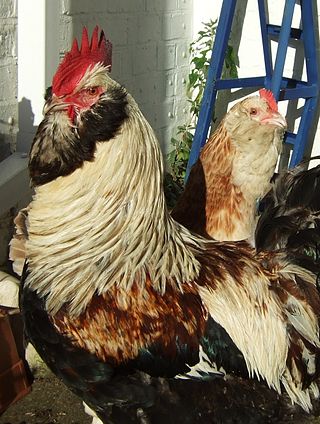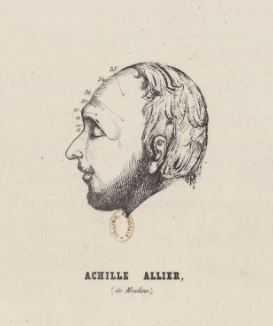
Poultry are domesticated birds kept by humans for the purpose of harvesting useful animal products such as meat, eggs or feathers, and the practice of raising poultry is known as poultry farming. These birds are most typically members of the superorder Galloanserae (fowl), especially the order Galliformes. The term also includes waterfowls of the family Anatidae and other flying birds that are kept and killed for their meat such as the young pigeons, but does not include wild birds hunted for food known as game or quarry.

The La Flèche, French: Poule de La Flèche, is a rare French breed of dual-purpose domestic chicken. It originates from the département of the Sarthe, in the Pays de la Loire region, and is named for the town and commune of La Flèche in that area, not far from the capital of the Sarthe, Le Mans. The breed was once famous for the fine quality of its meat; since the Second World War, numbers have fallen very low.

The Marans, French: Poule de Marans, is a French breed of dual-purpose chicken, reared both for meat and for its dark brown eggs. It originated in or near the port town of Marans, in the département of Charente-Maritime, in the Nouvelle-Aquitaine region of south-western France.

The Braque du Bourbonnais is a breed of gundog, of rustic appearance, sometimes born with a short tail, with a coat ticked with liver, fawn, black, or white

The poulet de Bresse or volaille de Bresse is a French chicken product which has appellation d'origine contrôlée status, and which was registered as a Protected Designation of Origin under EU and UK law as Volaille de Bresse / Poulet de Bresse / Poularde de Bresse / Chapon de Bresse. It may be produced only from white chickens of the Bresse Gauloise breed raised within a legally-defined area of the historic region and former province of Bresse, in eastern France.

The Campine is a breed of domestic chicken originating in the northern part of Belgium. It is named for the Campine region of north-eastern Belgium and south-eastern Netherlands. It was known there as the Kempisch Hoen.

The Houdan or Poule de Houdan is an old French breed of domestic chicken. It is named for its area of origin, the commune of Houdan, in the département of Yvelines to the west of Paris. It belongs to the crested chicken group, is muffed and bearded, has an unusual leaf-shaped comb, and has five toes on each foot rather than the usual four.

The Faverolles is a French breed of chicken. The breed was developed in the 1860s in north-central France, in the vicinity of the villages of Houdan and Faverolles. The breed was given the name of the latter village and the singular is thus also Faverolles, not Faverolle. The final "s" is silent in French.

The Crèvecœur is an endangered historic breed of crested chicken from the Pays d'Auge, in the Calvados département of Normandy, in north-western France. It is named after the commune of Crèvecœur-en-Auge. It is related to the La Flèche and to other Norman breeds such as the Caumont and Caux and the extinct Pavilly; the Merlerault was formerly considered a sub-type of the Crèvecœur.
The Nankin Bantam or Nankin is a British bantam breed of chicken. It is a true bantam, a naturally small breed with no large counterpart from which it was miniaturised. It is of South-east Asian origin, and is among the oldest bantam breeds. It is a yellowish buff colour, and the name is thought to derive from the colour of nankeen cotton from China.

The Chantecler is a breed of chicken originating in Canada. The Chantecler was developed in the early 20th century, at the Abbey of Notre-Dame du Lac in Oka, Quebec. It is extremely cold-resistant, and is suitable for both egg and meat production.

The Barbu d'Anvers, Dutch: Antwerpse baardkriel, is a breed of bantam chicken from Belgium. It is a true bantam, and has no full-sized counterpart; males weigh about 700 grams and hens about 600 g. The Barbu d'Anvers is one of the oldest bantam breeds, and is thought to have originated in the province of Antwerp in northern Flanders. It is the only Belgian bantam breed not threatened with extinction. In the United States it may be called the Antwerp Belgian or Belgian Bearded d'Anvers.

Achille Allier (1807 in Montluçon – 3 April 1836 in Bourbon-l'Archambault was a French writer, art critic and archaeologist.

The Bourbonnais Donkey, French: Âne bourbonnais, is a breed of domestic donkey from the historic region of the Bourbonnais, which corresponds roughly with the modern département of Allier, in the Auvergne region of central France. It was in the past used as a pack animal, for hauling barges, and to pull light gigs. The breed was recognised by the Ministère de l'Agriculture, the French ministry of agriculture, in 2002. The stud book is kept by the Association de l'Ane Bourbonnais, an association of breeders.
The Barbu de Grubbe, Dutch: 'Grubbe baardkriel', is a breed of bantam chicken from Belgium. It is a true bantam, and has no full-sized counterpart; males weigh about 700 grams and hens about 600 g. It is a tail-less variant of the Barbu d'Anvers, and is otherwise similar to it in every respect. The same colour varieties are accepted for the Barbu de Grubbe as for the Barbu d'Anvers.

The Alsacienne or French: Poule d'Alsace is a breed of domestic chicken from Alsace, in eastern France. It was selectively bred in the 1890s, at a time when Alsace was part of the German Empire. Unlike most other French breeds, it has not been cross-bred with imported Oriental stock.
The Pictave is an endangered French breed of bantam chicken. It is named for the Pictavi, the tribe which gave its name to the former Province of Poitou, now part of the region of Nouvelle-Aquitaine. It is a true bantam, and has no full-sized counterpart; it is the only true bantam of France. Cocks weigh about 800 grams and hens about 600 g. It was created in the twentieth century by Raymond Lecointre, who used the hens to incubate his pheasant eggs and raise the chicks.

Poularde is culinary term for a chicken that is at least 120 days old at the time of slaughter and fattened with a rich diet that delays egg production. In the past it was common to spay the chickens early in life to ensure desirable meat quality, similar to the castration of a capon.
Bourbonnais is a historic province in the centre of France.















